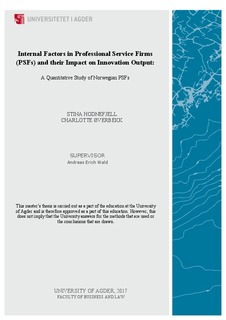| dc.description.abstract | The purpose of this study is to contribute to the understanding of Norwegian Professional
Service Firms (PSFs) by exploring the effect of internal factors’ impact on innovation output.
The four internal factors selected for this study are (1) organizational inertia, (2) training, (3)
human capital and (4) innovation culture. The economy is becoming increasingly knowledge
based, and at the same time, the importance of innovation is becoming more prevalent in the
business world. Even among PSFs, that are perceived as conservative, innovation is now
becoming critical for survival. However, it is challenge to become a successful innovator, as
there are many factors that may influence the innovation process. Overall, the research
associated with the internal factors’ impact on innovation output in PSFs is limited, and this
will be the first study on the topic in Norway.
The study has a quantitative approach and investigates innovation behavior by analyzing
primary data obtained from 142 classic and neo-classic Norwegian PSFs. Through this study,
we have defined a measure on the extent to which the different internal factors exist among
Norwegian PSFs and a measure on the level of innovation output among them. We have
established that there is a statistical significant relationship between organizational inertia and
innovation output, and innovation culture and innovation output. Alongside, we have found that
human capital and training is high among all respondents. Further, our study show that size
does not have a significant controlling effect on any of the relationships, while age have a
significant impact the relationship between innovation culture and innovation output. The last
control variable, sub-sector, was only analyzed at the descriptive level, and it is found that there
are clear differences between neo-classic and classic PSFs. In addition, the results display that
Norwegian PSFs have rather high investment rates in innovation activities, and that there is a
positive relationship between the investment rate and innovation output.
Key Words: Professional Services Firms, Innovation, Internal Factors, Innovation Output,
Norway | nb_NO |

